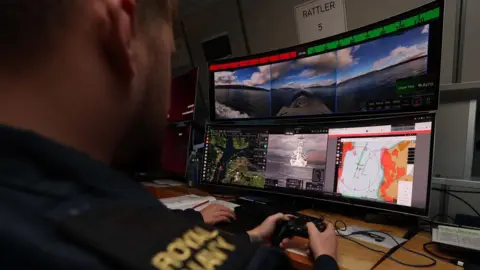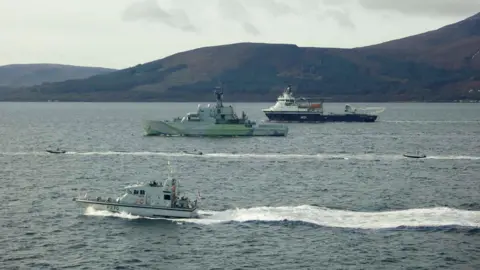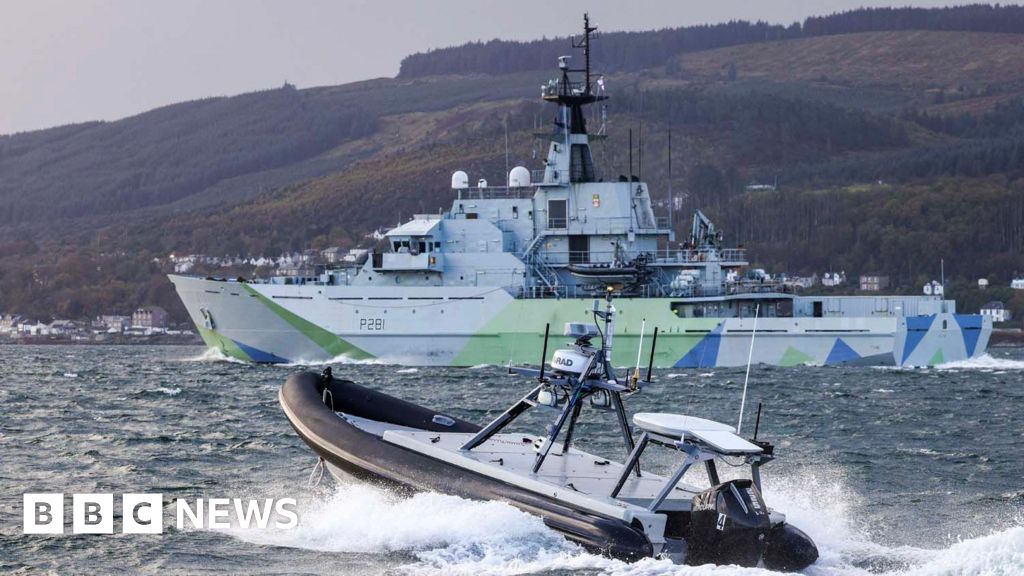




 LPhot Daniel Bladen
LPhot Daniel BladenA flotilla of uncrewed “wolf pack” drone boats has successfully been used to escort warships in a Royal Navy and Army trial.
The five vessels “swarmed” around HMS Tyne and HMS Stirling Castle off the coast of Scotland – remotely piloted by personnel 500 miles (804km) away on board XV Patrick Blackett in Portsmouth naval base.
The Navy said it was a “milestone” demonstration of how it could use such technology in a real-life scenario.
With camera and sensor data being fed back to Patrick Blackett, five 7.2m autonomous Rattler boats safely escorted the two ships playing the role of foreign warships during the 72-hour “milestone” training exercise, it said.
 LPhot George Seymour
LPhot George SeymourThe demonstration was a culmination of months of trials by the Navy’s Disruptive Capabilities and Technology Office (DCTO) and the Fleet Experimentation Squadron (FXS).
Each of the Rattler boats were operated by a two-person team, with one responsible for piloting the drone and the other monitoring and operating onboard systems, as well as helping to manage live data streams.
Cdr Michael Hutchinson said: “This is a really important moment for the Royal Navy as we progress towards a Hybrid Navy of crewed and uncrewed platforms.
“We have been using autonomous systems for some time but not like this. It is a technology that will continue to develop and it will fundamentally change the way we fight.”
 LPhot Daniel Bladen
LPhot Daniel BladenIn a statement the Navy said the vessels, based on a rigid inflatable boat (RIB), have been designed to eventually operate fully uncrewed, unlike previous drones.
It said: “Each vessel can operate individually or as part of a swarm. They can be pre-programmed with mission profiles, navigational routes and can work together as a ‘wolf pack’ on operations.
“In time they will be able to operate without direct human control.”
The demonstration also saw the vessels work with P2000 HMS Biter of the Coastal Forces Squadron and a Merlin helicopter.
Cdr Hutchinson said: “In recent years we have seen the effect that autonomy and uncrewed systems can have at sea, on land and in the air, especially in Ukraine.”
 LPhot Daniel Bladen
LPhot Daniel BladenBrig Jaimie Roylance, Royal Navy Chief Technology Officer, said the exercise was an “important moment in the history of the Royal Navy”.
The brigadier said: “It is the first time we have been able to field a capable, mission ready, deployable uncrewed system at sea and it is the first major success for the DCTO.
“The work that FXS, the Coastal Forces Squadron, Royal Marines and Army have done to develop not just the platforms but the way we train them and the way we fight with them has been astonishing and completed in record time.”
Source link

اترك تعليقاً